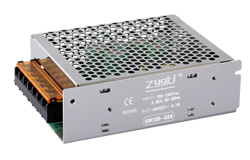বাতৰি
How to Build an AC-DC Converter
Author: ZYG Power Module Time: 2023-4-15
An AC-DC converter is an electronic circuit that converts alternating current (AC) to direct current (DC). It is an essential component in many electronic devices, such as power supplies and battery chargers. In this article, we will explore how to build an AC-DC converter.
Step 1: Gather Components
The first step is to gather all the necessary components. You will need a transformer, a diode bridge, a capacitor, and a voltage regulator.
– Transformer: A transformer is used to step down the AC voltage to a lower level. The transformer should have a secondary winding with a voltage rating that matches the desired output voltage of the converter.
– Diode Bridge: A diode bridge is used to convert AC to DC. It is made up of four diodes that are arranged in a bridge configuration.
– Capacitor: A capacitor is used to smooth out the DC voltage. It acts as a filter to remove any AC ripple that may be present in the output.
– Voltage Regulator: A voltage regulator is used to regulate the output voltage of the converter. It ensures that the output voltage remains constant even when the input voltage or load changes.
Step 2: Wire the Transformer
The second step is to wire the transformer. Connect the primary winding to the AC power source. The secondary winding should be connected to the diode bridge.
Step 3: Connect the Diode Bridge
The third step is to connect the diode bridge. Connect the positive (+) and negative (-) terminals of the diode bridge to the secondary winding of the transformer.
Step 4: Add the Capacitor
The fourth step is to add the capacitor. Connect the positive (+) terminal of the capacitor to the positive (+) terminal of the diode bridge. Connect the negative (-) terminal of the capacitor to the negative (-) terminal of the diode bridge.

Step 5: Install the Voltage Regulator
The final step is to install the voltage regulator. Connect the output of the diode bridge to the input of the voltage regulator. Connect the output of the voltage regulator to the load.
Step 6: Test the Converter
Before using the converter, it is important to test it to ensure that it is working properly. Use a multimeter to measure the output voltage of the converter. The output voltage should match the desired output voltage of the converter.
In conclusion, building an AC-DC converter is a straightforward process that requires a few basic components. By following the steps outlined in this article, you can build your own AC-DC converter for use in various electronic devices.
পূৰ্ৱবৰ্তী: AC-DC Converter: Converting Alternating Current to Direct Current
এটাৰ পাচৰ: How to Build an AC-DC Converter
প্ৰাসংগিক তথ্য
-
2023-6-18
Custom Type Power Series: The Ultimate Guide to Creating Unique and Effective Typography
Typography is a crucial aspect of graphic design. It's the art and technique of arranging type to make written language legible, readable, and appealing when displayed. Custom typography takes it a step further by creating unique and personalized typefaces that reflect the brand 's personality. In this guide, we'll explore the basics of typography, the benefits of custom typography, and the steps to create your own custom typeface. Typography Basics Typography has its own language with terms like serif, sans-serif, kerning, tracking, and leading. Let's break them down: - Serif: A small line or stroke attached to the end of a letter or symbol. - Sans-serif: A typeface that does not have serifs. - Kerning: The process of adjusting the...
সবিশেষ চাওক -
2023-10-27
Versatile Adjustable Power Supply Module: The Ultimate Solution for Your Electrical Needs
Introduction: Having a reliable and versatile power supply is crucial for various applications. Whether you are an electronics hobbyist, a professional engineer, or a student working on projects, having a power supply that can cater to your specific electrical needs is essential. Thankfully, the Versatile Adjustable Power Supply Module is here to meet your demands and provide you with the ultimate solution. Key Features: 1. Adjustable Voltage and Current Output: One of the standout features of this power supply module is its ability to adjust both voltage and current output. With a voltage range of 0-30V and a current range of 0-10A, you can easily tailor the power supply to match the requirements of your specific electrical devices or circuits....
সবিশেষ চাওক -
2023-6-12
Bidirectional DC-DC Converter: Efficient Power Conversion in Both Directions
The need for efficient power conversion is becoming increasingly important in today's world. As the demand for energy continues to grow, it is essential to find ways to optimize power conversion in various systems. One such system that requires efficient power conversion is the bidirectional DC-DC converter. The bidirectional DC-DC converter is a type of power converter that can transfer energy in both directions. This means that it can convert DC voltage from a source to a load, and also from a load to a source. This bidirectional functionality is particularly useful in applications where energy needs to be transferred back and forth between two sources, such as in hybrid electric vehicles and renewable energy systems. The efficiency of power...
সবিশেষ চাওক -
2023-7-11
ZP Series AC DC Converter: Efficient Power Conversion Solution
Introduction: In today's technologically advanced world, the demand for efficient power conversion solutions has never been higher. The ZP Series AC DC Converter is a revolutionary product that offers a reliable and efficient solution for converting alternating current (AC) to direct current (DC). This article will delve into the features, benefits, and applications of the ZP Series AC DC Converter, highlighting its significance in various industries. Features: The ZP Series AC DC Converter boasts an array of features that make it a standout choice for power conversion needs. Firstly, it offers a wide input voltage range, making it compatible with various power sources. This flexibility ensures that the converter can be used in diverse environments without any issues. Additionally, the...
সবিশেষ চাওক -
2023-6-14
Bidirectional DC-DC Converter: A Comprehensive Guide
A bidirectional DC-DC converter is a device that allows for power to be transferred between two DC power sources, such as a battery and a power grid, in either direction. This type of converter has become increasingly popular in recent years, particularly in the automotive and renewable energy industries. One of the main advantages of a bidirectional DC-DC converter is its ability to improve the efficiency of energy storage systems. These systems typically require a DC-DC converter to manage the flow of energy between the storage battery and the load, such as an electric vehicle or a home energy system. In a bidirectional converter, the same device can be used to charge or discharge the battery, depending on the needs...
সবিশেষ চাওক -
2022-5-5
চীন সৰু আকাৰৰ শক্তি মডিউল নিৰ্মাতাসকলৰ পৰিচয়
যেতিয়া আমি এটা শক্তি মডিউল বাছি লওঁ, আমি সাধাৰণতে শক্তি যোগানৰ ইনপুট, আউটপুট, ৰিপল, ব্ৰেকডাউন, উষ্ণতা, প্ৰমাণীকৰণ, আৰু অন্যান্য বৈশিষ্ট্যসমূহৰ মানদণ্ড চাওঁ। এইবোৰৰ বাহিৰেও আমি তলত দিয়া কথাবোৰ অনুযায়ী বিচাৰ কৰিব পাৰোঁ। 1. চাৰ্কিট নীতি আৰু ছল্ডাৰিং প্ৰক্ৰিয়া খালী বৰ্ডে স্বজ্ঞাত পদ্ধতি ব্যৱহাৰ কৰিব পাৰে, যেনে উপাদান আৰু পটিং মডিউলৰ এটা পৰিপাটি বিন্যাস উন্মুক্ত নোহোৱাকৈ আৰু আভ্যন্তৰীণ পৰিস্থিতি চাব নোৱাৰাকৈ। 2. চিপ উপাদান আৰু ট্ৰেন্সফৰ্মাৰ উপাদানসমূহৰ শক্তি যোগানৰ মূল IC, যিয়ে শক্তি আৰু উচ্চ- তাপমাত্রা প্রতিরোধের...
সবিশেষ চাওক


















